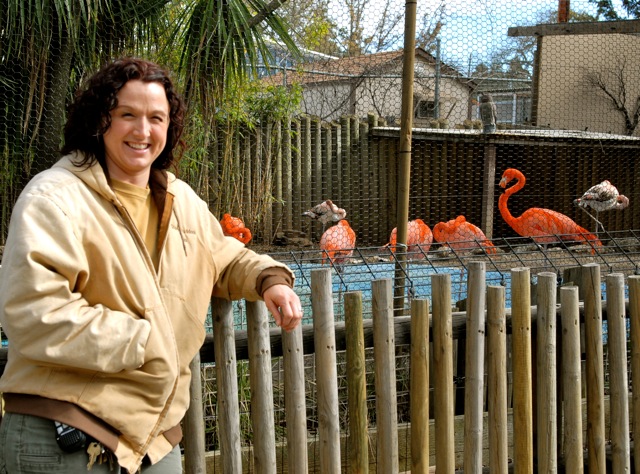

Animal Collection Manager, Kate Capela with the Charles Paddock Zoo collection of Caribbean Flamingoes. |
||
|
I had many questions to ask, and found Animal Collection Manager, Kate Capela to talk to. I asked her what the public could do to help the local zoo and she said, “Just walk through the gate.” By visiting often, buying snacks or lunch on the premises, purchases and souvenirs from the gift shop or even putting an extra five, ten, twenty or more in the donation kitty - all are a great help. Zoos are hit just as hard or worse than the rest of the world with the lousy economy and it is costly to keep them open. Kate said that it costs about $800,000.00 a year to keep this very modest size zoo operating. Breaking it down further, try over $60,000.00 per month! Think of it as costing a bit over two thousand dollars a day when you pass by the donation box. Another way to look at it is that it costs us a whole lot more to take the family to the movies than it does to visit a zoo, and a zoo is a real live experience, where we can interact with live animals. One advantage of a small zoo is the intimate feeling we get over a larger zoo. A sense of the zoo’s importance in the community is readily apparent, because here at our zoo we can attend and participate in fund raising events such as: zoo school workshops, Spring Zoo Camp, birthday parties, volunteer and docent work, Scout programs and puppet shows, to name a few ways our community is able to network with the zoo. Every zoo has similar events and programs for the public to participate in. Modern day zoos are also playing a new role in conservation. With species threatened and habitats disappearing worldwide, zoos are expanding their efforts far beyond merely keeping animals alive in captivity. Today’s zoo is no longer simply a modern-day ark and many zoos have become strongly proactive in the conservation of wild animals, reintroducing endangered species, and restoring habitats. Zoos support conservation in a variety of ways, big and small. They raise and donate financial support, medical, educational and operational supplies to projects, raise awareness through lectures, classes and publications, donate expertise by sending vets and other staff to project sites and sell indigenous wares in their gift shops. |
Caribbean Flamingoes.
They band together with other zoos in their ecosystem to work on local conservation issues, breed and release species and provide medical attention to local wildlife. They also exercise their most valuable resource - education. As important as conservation is, so is education. People look to zoos as learning centers. >>More |
|
|
|
|
Copyright © 2011, Susie Christian |
